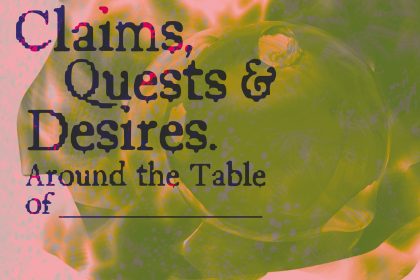In an expansive installation with video works, textiles, text and sculptural elements, to slip, to slide, to glitch explores moments of control, disruption, destruction and restoration in the production of landscapes through so-called green capitalism. Disruptions or glitches, as can be found, for example, in faulty satellite images of open-cast mines, are understood to refl ect interruptions in the landscape more broadly, with deep-seated implications for bodies (of humans, animals, plants and water) on the ground.
Larisa Crunţeanu and Sonja Hornung’s artistic research takes as its starting-point (post-) mining landscapes in East Germany and Romania. Together, they investigate how the desire for an ecological and just transformation collides with ongoing, profi t-driven extraction processes. Who benefits from the desire for change and restoration, and how does this repeatedly
negatively impact people and ecosystems?
A series of large-scale textile cyanotypes and hyper-coloured fake plants – species used to recultivate former mining landscapes – transform the gallery space into an imitation of a forest. In a video work embedded in the installation, two exploratory protagonists move through (post-)industrial coal mining landscapes in Lusatia and the copper mining region in the Apuseni Mountains, searching, marvelling, and observing. Transformed into skeletons, the artists refer to the toxicity of the scenarios and processes at play, while simultaneously destabilising their own physicality in relation to “artificial nature”. These elements are contextualised by text-based works.
to slip, to slide, to glitch blurs notions of nature and artifi ciality, because landscape is always partly produced by humans: here, either through the projected imaginary of full restoration, or through actual neglect. Hyper-coloured algal blooms and orange waters infused with ferric sulfates become the spectacular symptoms of enduring ecological disaster. At the same time, the project is dedicated to the productive power that arises when we do not see “natural” and “artificial”conditions as two separate entities, pointing towards the need to recognise practices that might embrace the wounds of the world, and take responsibility to care for the world as it is.
Larisa Crunțeanu’s practice as performer, video artist and sound collector moves from reality to fiction in an endless conversation with the viewer. Her works create contexts in which facts and memories are reactivated, encouraging a shared effort and the emergence of new practices. Many of her projects reflect on the notion of collaboration and the ideas existing behind objects and stories.
Sonja Hornung’s artistic practice takes as its starting-point crises spurred on by private property formats and fi nancialisation, investigating how these affect the relationship between bodies and spaces. Alongside her collaboration with Larisa Crunțeanu, collective work, for example with artist Daniele Tognozzi or Kollektiv x-embassy, have been important to her practice.
Sonja and Larisa’s artistic conversation began in 2015 with the body of work Femina subtetrix. Over the years, thematic threads from Femina subtetrix escaped into their individual artistic practices, and were picked up on again in later collaborations – including the ways in which bodies gendered female negotiate the production of our own images in privatised spaces, and the power of camouflage as it collapses the boundaries between “natural” and “artificial”.
Program
After Exhaustion
Screenings // 12.6.2024 // 19:00
Moving between Maritza Iztok, Bulgaria; Saxony and Thuringia, Germany;
and Indigenous Wayuu territory in North Colombia respectively, the works
investigate top-down visions of control as they splinter into technologies
for war and digging. After exhaustion, images, land, and bodies still harbour
stubborn counter-myths.
Nature Morte, Nikola Stoyanov, 2023 (5:20)
Sonne Unter Tage, Mareike Bernien & Alex Gerbaulet, 2022 (39:00)
Excerpts from El Leon Durmiente, Tama Ruß, 2024 (31:00)
Followed by an artist talk with Tama Ruß & Alex Gerbaulet
Other Transitions
Screenings // 13.6.2024 // 19:00
Wannabe starlet trees, a phone sex worker in Vetagrande Zacatecas,
Mexico, and animated Harz Roller canaries in Tenerife precede an underground conversation about transitioning. These works reshuffle the categories of human, nature, and artifice, pointing towards moments of indefinition, refusal, and chasing collective dreams against the odds.
Congratulations! You are still in the running for becoming, Ann Oren, 2015 (10:22)
Heavy Blood, Naomi Rincón-Gallardo, 2018 (18:43)
Excerpts from Des Goldes Klang (Golden Tone), Barbara Marcel, 2023 (ca. 40:00)
Followed by an artist talk with Barbara Marcel (online)
Closing event with Artist Talk & Open Exchange
12.7.2024 // 19:00-21:00
Shortly after the exhibition to slip, to slide, to glitch (Larisa Crunțeanu & Sonja Hornung) opened, the European Commission approved the German government’s offer of up to 1.75 billion Euro to Leag – the company responsible for lignite (brown coal) mining in Lusatia, East Germany – in compensation for the closure of its mining operations by 2038 under the aegis of “green structural change”. In return, Leag is to invest in the recultivation of former open cast mines, as well as “alternative” energy infrastructure for the region. According to the investigative journalist group correctiv, Leag, which is a part of Czech oligarch Daniel Křetínský’s business empire, EPH, has bribed municipal waterworks to withhold information about alarming levels of sulphate in drinking water due to brown coal mining across Lusatia.
Against this background, this event will focus on selected objects, images, and texts gathered by the artists Larisa Crunțeanu and Sonja Hornung while preparing the exhibition to slip, to slide, to glitch. Together, we will examine photographic documentation of early attempts to recultivate open-cast mines in Lusatia in the 1920s, satellite imagery of (post-)mining landscapes, as well as selected news reports, and excerpts from the writings of queer-feminist activist-theorists such as Legacy Russell and Catriona Sandilands. We will think together about what it means for city dwellers when, under the guise of a “green transition”, they continue to be dependent on state-subsidised, financialised, and profit-driven investment into energy infrastructure in a rural “elsewhere”. Since this model appears to arise out of, and reproduce, a toxic relationship between bodies and landscapes, how might this relationship be lived differently?







































